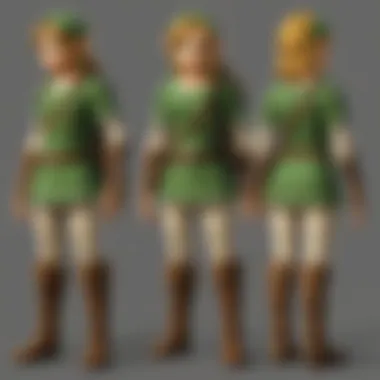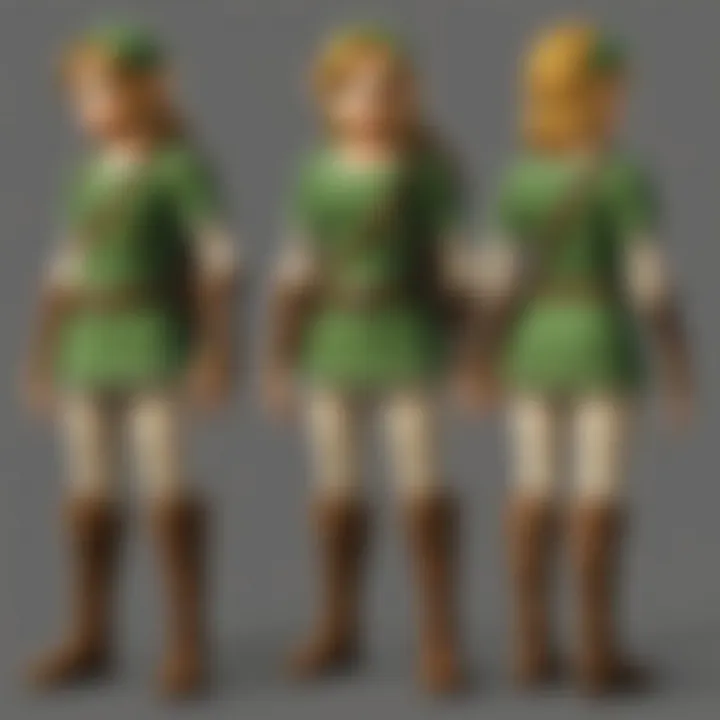Exploring Zelda's Handheld Legacy on the Nintendo DS


Intro
The Zelda franchise has long been known for pushing the boundaries of gaming, particularly with its entries on the Nintendo DS platform. This article delves into how titles such as The Legend of Zelda: Phantom Hourglass and The Legend of Zelda: Spirit Tracks embrace the handheld format while providing exciting and immersive experiences. Users of the Nintendo DS were drawn into rich narratives paired with unique gameplay mechanics that drove the franchise’s legacy forward. As we explore gameplay features, character arcs, and interconnected lore, a comprehensive picture of these titles emerges, enriching our understanding of their impact on the larger gaming landscape.
Game Reviews
Gameplay Features and Mechanics
The gameplay in Phantom Hourglass introduces players to a new level of interactivity. The use of the Nintendo DS’s touch capability redefined how players engage with the world of Zelda. Unlike earlier titles that relied heavily on button mashin, this game utilized gestures for actions such as movement, item selection, and puzzles.
Spirit Tracks, on the other hand, blended the exploration elements with a fresh take on transportation. Players navigate through the land using a locomotive, which injects a charming dynamic into an often familiar exploration rhythm. This use of train travel meshed beautifully with core Zelda mechanics, making exploration an exciting experience rather than just moving from point A to point B.
Storyline and Quests
Narrative in both Phantom Hourglass and Spirit Tracks is rooted deeply in classic tropes of courage and adventure, yet they offer polished storytelling suited for handheld gaming. A continuation of the series requiring an intricate dance between heroes and villains, Phantom Hourglass revisits the charming character design forged in its predecessors and expands upon it.
In Spirit Tracks, Link finds a new partner in Princess Zelda herself, who becomes an ethereal entity aiding him against the forces of evil. This development allows for engaging puzzle-solving together, highlighting collaboration amidst the more traditional good versus evil backdrop. Quests in both titles prompt analytical thinking as players immerse themselves in layers of lore.
Visuals and Sound Design
Visual expression in these titles reflects considerably on the hardware. Both games showcase a colorful, polygonal art style that embraces a dynamic narrative instead of focusing on hyper-realism. Art direction in Phantom Hourglass presents bright, vivid landscapes, all characterized by charm tailored for handheld play.
In terms of audio, both installments provide noteworthy scores complementing storytelling and gameplay. The music is atmospheric. Sound effects maintain immersion when solving puzzles or facing enemies. This auditory landscape formulates a familiar yet refreshing template across both titles.
Comparison with Previous Titles
When juxtaposed with leading titles like The Legend of Zelda: The Wind Waker, earlier game structures may seem primitive. However, the impactful learning curve established in these handheld versions exhibits refined progression. Mechanics simplified through the touchscreen interface leverage interactivity, juxtaposing earlier buttons with more engaging obstacles and challenges.
In sum, Phantom Hourglass and Spirit Tracks mark significant additions to the Zelda series, boasting captivating narratives, mechanical innovation, and a shining commitment to the values forged by their console-based predecessors.
Preamble to Zelda on the DS
The advent of handheld gaming platforms revolutionized the video game landscape, allowing players to experience rich narratives and engaging gameplay on the go. Within this space, the Zelda franchise has made notable strides, particularly on the Nintendo DS. The counterpoint of engaging stories and intricate gameplay found in handheld versions like The Legend of Zelda: Phantom Hourglass and The Legend of Zelda: Spirit Tracks solidified Zelda’s status within portable gaming history.
Zelda's Importance on DS is multifaceted. The franchise cultivated a deep connection with players while introducing them to innovative design approaches that leveraged the unique capabilities of the DS. Among these innovations are stylus control and dual-screen interactions, elements that match refreshingly with dynamics of storytelling core to the Zelda games.
This article aims to cover the importance and impact of Zelda on the Nintendo DS. Special attention will be devoted to specific titles and core design considerations that made them popular with audiences. Factors like story depth, character evolution, and novel gameplay mechanics played significant roles in this transition into the handheld format.
The topic of Zelda on the DS reminds us that handheld experiences are not mere adaptations but rather full-fledged entries into a beloved franchise. The growth of the series on this platform is a testament to enduring creativity and adaptability in design and storytelling. Moreover, understanding this transition highlights how gaming habits have evolved over the years, impacting how gamers interact with their favorite franchises.
Through examining these elements, we discover the unique lens that handheld adventures like those seen on the Nintendo DS provide, enriching the overall legacy of the Zelda franchise. As we delve deeper, a coherent narrative will unpack these Dee ambers, guiding audiences to appreciate both casual play and applied strategy involved in immersive handheld tenure.
Overview of the Handheld Console
The Nintendo DS was a pivotal handheld gaming console that reshaped the way games were developed and experienced. This console brought together a unique set of features that enhanced gameplay. Most notable was the dual-screen layout, allowing for higher level of interaction. Players experienced depth in their gaming that wasn’t possible on other consoles of its time. The bottom touchscreen was notable for introducing touch controls, which gave players new methods of engaging with their games.
Key features of the Nintendo DS include:
- Dual screens promoting innovative gameplay.
- A touch screen adding a new level of interactivity.
- Portable with effective battery life suitable for gaming on the move.
- Wireless capabilities allowing multiplayer options scarce for handheld devices.
The relevance of the Nintendo DS in this analysis cannot be overstated. The device served as the foundation for notable titles in the Zelda franchise. It merged classic gameplay with modern thematic elements. As players experienced these games, they were not just engaging in a casual experience, but exploring deep narratives and intricate worlds.
"The Nintendo DS opened new opportunities for game developers, inspiring unique gameplay mechanics and storytelling methods."
In understanding the success of Zelda on this console, we analyze how these innovations played vital roles. The intertwining of formats and gameplay sparked a dialogue among fans and critics, resulting in lasting impact on the gaming landscape.
The Nintendo DS Platform
The Nintendo DS platform introduced new ways for players to experience gaming. Not only was it lightweight and portable, but it also provided intuitive interactions that appealed to a broad audience. The emphasis on both accessibility and engaging gameplay ensured it reached both casual gamers and dedicated fans like those of the Zelda series.
One significant aspect was its backward compatibility. The DS could play Game Boy Advance games, catering to an established fanbase while attracting new players. Enriching the experience further, it had a robust library of titles spanning various genres, not limited to action-adventure. This versatility left space for crossover appeal, allowing more people to access and enjoy titles like The Legend of Zelda: Phantom Hourglass and The Legend of Zelda: Spirit Tracks.


In addition, the Nintendo DS cemented its place in handheld history with its innovative use of wireless capabilities, enabling online play and local wireless multiplayer. This addition enhanced community engagement and drew Zelda fans into competitive scenarios traditionally reserved for home consoles. By fostering social interaction, it shifted solo gaming into a shared experience.
Technological Innovations
Significant technological advances marked the emergence of the Nintendo DS. These innovations not only redefined portable gaming but set a benchmark for future handheld devices. The concurrent screens of the DS were revolutionary. Having two displays opened a pathway for expansive game design where developers could integrate their puzzles and combat mechanics seamlessly across screens.
The touchscreen interface was a key innovation. Designers created experiences where puzzle-solving and character interactions could dynamically unfold. This allowed a more immersive experience in titles such as Phantom Hourglass.
- Gesture recognition improved input methods.
- Voice recognition in select titles expanded gameplay further.
- Enhanced graphics tied with dual processors improved system capabilities for a wider array of genres.
Key Titles in the Franchise
The distinction of key titles within the Zelda franchise on the Nintendo DS holds significant weight. It is essential to delve into these core games to understand their contributions to both the franchise and the realm of handheld gaming. The different elements of each title present unique benefits and considerations that shape gameplay and storytelling experiences.
The Legend of Zelda: Phantom Hourglass
Storyline and Setting
The storyline of Phantom Hourglass resumes from the ending of The Legend of Zelda: The Wind Waker. It follows Link's adventures as he searches for Princess Zelda. Central to its appeal is the art direction that combines a bright and cartoonish style. This setting creates an atmosphere of whimsy and adventure.
However, the ocean’s interrupted sense of exploration remains a point of discussion among players. Gamers enjoy the expansive environment but sometimes find traversal tedious.
Gameplay Mechanics
Phantom Hourglass redefines traditional gameplay mechanics by making use of the Nintendo DS's touchscreen. This versatile input method invites players to slash their enemies by swiping the stylus, a feature that connects them to the in-game experience in an immersive way. Combining exploration with puzzle solving establishes a fresh playground for Zelda fans.
While the mechanics entertain, some older players may gasp at the absence of classic button inputs, leaving debates about authenticity within the franchise.
Character Analysis
In Phantom Hourglass, Link is not just a silent hero. He interacts more dynamically, allowing players to engage with his personality apart from statically fighting foes. The limitations of his companion, Ciela, enable explorations of his character – tension and teamwork become the avatar’s essence.
This growth in character depth enhances Player involvement in Phantom Hourglass.
The Legend of Zelda: Spirit Tracks
Storytelling Techniques
Spirit Tracks offers an engaging and rich story that utilizes a train as a fundamental transportation mode. This train concept reflects the theme of progress but poses limitations on players who prefer more open travel mechanisms. The communication between Link and Zelda sparks attention, revamping player relationships with a known character.
Some say that the tie between Link and Princess Zelda facilitates storytelling better than previous installments.
Game Design Elements
With a focus on spatial awareness, Spirit Tracks emphasizes a world that is uniquely designed around train tracks. Maintaining attention on tracks is refreshing, nudging players to process the environment digitally through visualizations rather than solving conventional puzzles. Each segment of track holds ponders for exploration and conflicts, shifting somewhat from more grounded puzzle designs of earlier titles.
Yet, others find alignment with train travel a slight unwilling sacrifice of freedom in face miles of beauty.
Character Interactions
Character interactions tend to breathe life into Spirit Tracks. Link’s journey naturally leads to myriad engagements, underscoring the collaborative heroics. Users explore relationships through characters both comical and cunning, enhancing player immersion with unique dialogues and dynamic relationships, especially with Zelda.
The quirky bureaucratic personalities provide funny elements that soften the traditional heaviness seen in some former games.
“The mechanics of character interaction set these DS titles apart, making each engagement memorable.”
Comparative Analysis of the DS Titles
In exploring the Zelda franchise, it becomes vital to conduct a comparative analysis of its DS entries. Such an analysis unveils the distinct gameplay styles, storytelling techniques, and character development arcs that both Phantom Hourglass and Spirit Tracks present. This facet serves not just for appreciation but for understanding how various elements resonate with players, influencing their gaming experience and expectations of the franchise.
Gameplay Comparison
While both titles target similar gameplay mechanics, essential differences distinguish them at their core. The Legend of Zelda: Phantom Hourglass emphasizes touchscreen capabilities, encouraging a tactile approach to solving puzzles and fighting through enemies. Players can draw paths for Link to follow or swipe to execute various actions. This design leverages the Nintendo DS's innovative features, making gameplay intuitive and engaging. The use of the map, which is drawn on the touchscreen, allows for a fresher approach to navigation and challenges.


Conversely, The Legend of Zelda: Spirit Tracks expands on these mechanics by integrating a train system that dictates movement through the game world. This approach not only features an innovative method of traveling but also necessitates a different layer of responsibility as players must manage the train’s speed and direction. The interaction between elements enhances the puzzle-solving aspects, as players often need to think about how to align their journey with other gameplay tasks at hand.
Both games exhibit strengths in encouraging exploration. However, Phantom Hourglass is more linear, with segments tied to specific objectives within regions, while Spirit Tracks fosters a greater open feel by allowing smoother transitions between its environments.
Narrative Arcs
The narrative feedback loop between player and game has distinctive variations in these two offerings of the Zelda franchise. In Phantom Hourglass, the story is more simplistic, revolving around the quest to save Tetra and return her to a state of normalcy. Here, emotional engagement is heavy on the adventure-y aspects that Zelda fans often appreciate.
On the other hand, Spirit Tracks offers a more complex plot. It introduces themes of legacy, particularly through Princess Zelda, who acts independently as a spiritual guide aiding Link throughout his endeavor. The deeper connection to the spirit world diversifies Spirit Tracks further, creating a multi-dimensional narrative that gives room for significant character interactions. This aspect enhances player investment, showcasing the trials and triumphs of Link and Zelda beside their adventure.
Overall, understanding these gameplay and storytelling differences between Phantom Hourglass and Spirit Tracks helps underscore the creative directions within the Zelda series. Adopting unique approaches in these realms encourages players to engage further with each title while building upon prior installments within the franchise's rich history.
"Zelda on the DS redefined not just how stories could be told in games, but also how players related to their environments while playing."
Character Development in DS Titles
The development of characters in the DS titles represents a crucial aspect that enriches both the narrative experience and player engagement. These characters, rooted in the beloved Zelda legacy, extend beyond their simplistic appearances. The interactions between characters render considerable depth, embellishing the overall lore while making gameplay not only enjoyable but also emotionally resonant.
Link as a Character
In the handheld entries, especially in Phantom Hourglass and Spirit Tracks, Link embodies more than just the socially recognized hero. In these games, Link’s persona displays significant growth that hints at his consistent heroism while allowing for moments of vulnerability and charm. He engages with various personalities, which helps to highlight his evolving traits such as loyalty, courage, and a deceiving yet appealing innocence that resonates clearly through dialogue, and action.
Additionally, in contexts involving problem-solving or progression in game quests, Link illuminates resourcefulness and determination. Each boss fight acts as a culmination of encounter ing the very essence of challenges common to his adventures. Within this game layout, he often faces a moral clarity not typically explored in earlier Zelda titles. The character shifts from merely responding to requests from others to making independent decisions to protect Hyrule, showcasing maturation.
Princess Zelda's Role
Princess Zelda, traditionally positioned as a damsel, is etched differently in the DS games. In Phantom Hourglass and Spirit Tracks, she contributes significantly to the narrative, thus defying classic expectations. Her spirit is demonstrated as inherent strength, often guiding Link even in helps that are indirect.
In Spirit Tracks, Zelda is not just an ethereal figure, as she travels alongside Link across realms. This partnership roots her in the action, breaking away from pervasive tropes. Moreover, her role weaves storytelling and cooperation, redefining femininity and strength. As the titles unfold, players witness Zelda's resilience as she battles alongside Link in a fight against oppression by Malladus, which foregrounds her intrinsic role rather than divinely inspired but passive nuisances that plagued earlier titles.
Through their camaraderie, Link and Zelda not only tackle quests but also reinforce the concept that partnership is critical. As developments sweep across narratives, she is not merely an objective, rather, she actively influences Link’s journey while displaying empowerment.
In summary, Link’s growth alongside Zelda's evolving role encapsulates a narrative strategy that means not just gameplay goals but their relationship's staple as beacon promoting synergy and mutual respect.
Understanding character character development in these titles enhances experiencing adventure, making it pleasurable while ultimately carrying deep analytical undertones about identity and agency.
Artistic Direction and Aesthetics
Artistic direction and aesthetics play a vital role in any video game, especially in iconic series like Zelda. The internel visual and auditory experience shapes how players connect with the game world. This section examines how the distinct styles and designs underlying the Nintendo DS titles enhance players’ immersion, elevating the gameplay experience.
Visual Styles
The visual style of The Legend of Zelda: Phantom Hourglass and The Legend of Zelda: Spirit Tracks reflects the artistic ambition behind the Nintendo DS titles. These games lean towards a cel-shaded look that lends a vibrant and approachable quality, appealing to a broader demographic.
Phantom Hourglass employs a visual narrative that doesn’t just look good, but actively engages players. Characters and environments are colorful and distinctive. This suits the lighter story tone and invites players into its more whimsical aspects.
In contrast, Spirit Tracks also uses cel-shading but adopts a slightly darker visual tone. The elaboration in character designs resonates with the more mature narratives involved, especially focusing on themes such as legacy and sword battles. This duality in artistic styles demonstrates how aesthetic choices can align closely with gameplay goals and story arcs.
- Unique Color Palettes: Each title utilizes a unique color scheme. This care in color has significance, as it often aligns with emotions or themes in gameplay.
- Character Design: Characters are engaging and recognizable, allowing players to form emotional ties throughout these handheld adventures.
Equally compelling is the exploration of the game worlds. Players notice how spaces in Phantom Hourglass feel like environments waiting for discovery. In Spirit Tracks, vast landscapes harmonize quests and small narrative encounters seamlessly, enriching player engagement with the world.
Audio Design
Audio design in both titles contributes significantly to the overall experience, bringing environments and characters to life. The music and soundscapes underlie the gameplay's emotional impact and set the ambiance for various scenes and encounters. Koji Kondo's compositions have long since defined an essential element in the Zelda series.
In Phantom Hourglass, a variety of energetic tracks elevate exploration and reflect projective feelings of adventure, notably during boss battles. Each composition pushes narrative pacing and encourages players to interact with the world more actively.
Spirit Tracks, on the other hand, explores sound atmospherics as well. The sound design enhances critical moments, with train whistles becoming symbolic of both travel and foreboding. The audio cues are not just background noise; they are foundational elements creating a rich tapestry of sound that emerges alongside visual cues.
“Sound effectively becomes a character in its own right in these DS titles, guiding players emotionally.”


Here are key elements about audio in the DS titles:
- Distinct Melodies: Each installment features unique tunes that relate to specific settings or scenarios, enhancing players’ engagement.
- Dynamic Sound Effects: High-quality audio effects make the adventures feel alive, adding depth to challenges and interaction.
- Nullifying Distraction: Careful design minimizes soundclashes, preserving focus during crucial game moments, thereby guiding players effectively.
In summary, the artistic direction and aesthetics form a compelling foundation for the Zelda DS titles, making players’ experiences more memorable. The visual and audio choices tell overarching stories and resonate an emotional core throughout the adventures.
Impact on the Zelda Franchise
The Zelda franchise holds a respected position in video game history, enriched notably through the entries released on the Nintendo DS. This handheld platform allowed for unique innovations that influenced both the franchise and gaming as a whole. Consequently, the impact of these games extended beyond just their individual experiences. The advent of the touchscreen functionality on the Nintendo DS meant designers could explore different mechanics compared to prior console games. This not only shaped gameplay but also engaged players in novel ways.
Developments like these contributed to the ongoing evolution of Zelda’s identity. By navigating through The Legend of Zelda: Phantom Hourglass and Spirit Tracks, players encountered fresh gameplay mechanics that reinvigorated traditional styles. Elements such as sketching paths or directing characters through intuitive touchscreen controls present a clear shift in game design philosophy. With each new title, Zelda challenged and shaped genre standards, setting benchmarks that future games aimed to meet.
"The unique innovations on the DS created a space for experiments in gameplay that reignited the fans' passions and attracted new players to the series."
Innovation in Gameplay
The gameplay innovations presented through the DS titles effectively demonstrated how interactive elements could enhance storytelling and immersion. Phantom Hourglass introduced a real-time drawing mechanic allowing players to chart out sailing courses. This visual input not only created a hands-on experience but also enriched aspects of navigation and exploration within the game.
The essence of touchscreen interaction shaped the overarching theme of accessibility, bringing Zelda to audiences who may have been deterred by typical game complexities. Whether through map management or item selection, these features acted as conduits for engaging storytelling.
Furthermore, Spirit Tracks progressed this notion further by bringing train mechanics into the equation. Players had to construct and manage tracks while attempting to explore its expansive world, balancing time and resources efficiently. Such innovations enabled players not just to control Link's journey but also actively participate in the creation of their adventure.
Fan Reception and Critiques
Fan reception for these titles was predominantly positive, reflecting appreciation for the shifts brought forth in gameplay dynamics. Many praised the DS entries for boldly embracing handheld capabilities. The interactions were hailed for their fluidity and seamless integration into the fantastical realms.
On the other hand, critiques emerged regarding certain gameplay elements. Some players expressed frustration over the reliance on the DS touchscreen for a range of features. For instance, the difficulty of drawing precise paths while in combat confronted newer gamers unfamiliar with manual controls. Such struggles raised questions about balancing accessibility with deeper gaming mechanics. Over time, however, most players recognized that the associated challenges ultimately contributed to playing the game, leaving everyone engaged in discussions about both pros and cons.
As a result, the feedback surrounding these innovations paved the way for sustainable franchise growth and adaptability. The diverse opinions contributed profoundly to the game developers' listening process within the evolving landscape of handheld experiences. Embracing both compliment and critique, Zelda solidified its relevance in the larger context of value-driven gaming.
Integration with Portable Gaming Culture
The integration of Zelda into portable gaming culture represents an essential aspect of the franchise's growth. This section examines how the Nintendo DS versions of Zelda redefined user experiences and expectations around handheld gaming. For many fans, these games were a gateway to new interactivity and storytelling that utilized the unique features of the DS console.
Portability is a game changer. Players could now experience adventures on the go, making the gaming experience more versatile. The dual screens and touch interface utilized by titles like 'Phantom Hourglass' allowed for innovative mechanics that were not possible on desktop or console systems. These elements did not only enhance the gameplay; they encouraged creative design that influenced future portable titles.
From the onset, Zelda developed distinct features that resonated on the DS. Here are several elements that facilitated this convergence:
- Interactive Gameplay: The DS feedback system and touch mechanics made exploration and puzzle-solving feel refreshing. Players literally touched their path through the story.
- Enhanced Storytelling: By utilizing the two screens, developers brought narrative depth seldom seen in handheld games. A deeper integration of story into gameplay arose from utilizing dual displays, making scenes more interactive and engaging.
- Competitive Multiplayer Features: The DS introduced broader social gaming. Multiplayer features engaged users beyond solo adventures, leading to shared experiences which are common in modern gaming communities.
Overall, Zelda on the DS redefined how players engage with content. The fulfilment of on-the-go comfort met with immersive storytelling elevated gameplay standards across the industry.
Impact on Game Design Trends
The Zelda titles for the DS set a precedent for game design that reverberates through the industry. As developers observed how players interacted with these entries, they began incorporating similar elements in their titles. Specific trends emerged post-release that demonstrated this impact, such as:
Adoption of Touchscreen Mechanics: Many games followed the lead of Zelda, embracing intuitive control schemes that relied on direct interaction.
- Narrative-Driven Experiences: Story became a flagship aspect for handheld releases, with developers striving to create enriching plots that foster player connection.
- Hybrid Gameplay Models: Uniting genres such as action, puzzle, and strategy became prevalent as it enriched the potential of handheld titles.
Nostalgia in Modern Gaming
Zelda's presence on the DS elucidates a phenomenon in current gaming where nostalgia plays a crucial element. The aesthetics, stories, and characters retain appeal for both long-time fans and newer audiences inspired by the franchise's enduring charm.
This nostalgia has wide-reaching effects:
- Many Newer games draw inspiration from the mechanics established by Zelda titles.
- Revived interest in handheld gaming fuels new releases of entire franchises, re-establishing their relevance in a fast-paced world.
- Merching handheld charm with modern themes enhances game narrative while tugging at player memories, establishing a heartfelt connection.
The End: The Legacy of Zelda on DS
The Legacy of Zelda on the DS transcends mere entertainment. It embodies a significant evolution in both gameplay design and narrative approach within the handheld gaming sphere. The contributions of the titles developed for the Nintendo DS, particularly Phantom Hourglass and Spirit Tracks, have left lasting impressions on players and game developers alike.
These entries introduced innovative control schemes that leverage the dual screens and touch capabilities unique to the DS. These features are not easily replicated in traditional gaming setups and this set a new standard for future portability and interaction in video games. As players navigated dungeons and solved puzzles through intuitive touch mechanics, the lines between player and character blurred, enhancing immersion. This approach invited both casual gamers and series veterans to engage in ways previously unexplored.
The evolution of character depth, particularly for Link and Princess Zelda, provided emotional layers within their quests. It is not just battling foes that drives the story. Instead, their struggles, growth, and victory present a narrative steeped in relational dynamics. Characters are not mere avatars on a screen, but living entities with reasons and desires, making their fates intertwined with the player’s success.
Furthermore, the aesthetic choices in art and audio resonate deeply with the gamer community. The vibrant colors and charming sprites capture the essence of the franchise while encouraging new levels of emotional connection with the storyline overlay. The audio design further heightens comprehension of events, moods, and themes, adding bold strokes to an already rich palette.
In understanding the generational impact, the DS installments have inspired a discourse about gaming nostalgia and legacy unfolding across modern gaming. The two titles Phantom Hourglass and Spirit Tracks, notably expand the mythology of the Zelda universe. These games invite newer fans to explore the older canon, enriching both individual experience and the cash of game history.







